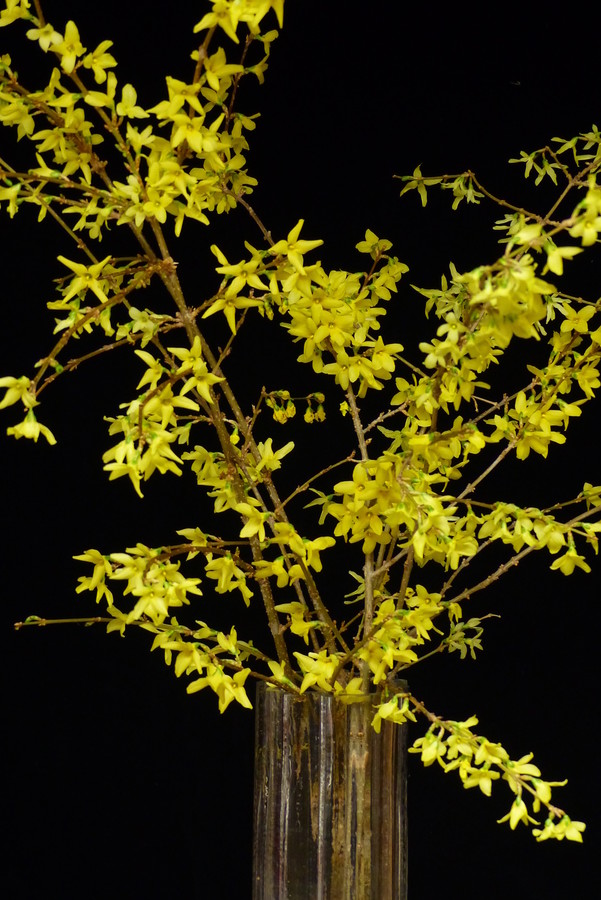Discover the mystery of forsythias revealed by spring
For most of the year, forsythias are just a scruffy, lanky bush. But its charms in the spring amply justify its place in so many gardens.
As part of the great spring sweep of yellow, I await its blooming to surround me with its golden splendor.
Instead this year, as I watched bush after bush bloom, I was disappointed with the sparseness of the flowers, so unlike my expectations. And the flowers that did bloom seemed concentrated at the branch tips instead of enveloping the shrub from top to bottom.
Since much of my gardening is done by the seat of my pants, I started reading to see what needed to be done to improve matters for next spring.
Not terribly surprising, it seems forsythia — like so many other bushes — require thoughtful pruning. With forsythia, there is no dominant trunk; the plant just puts up new canes during the growing season, and next year’s buds are set during the late summer.
Professional advice suggests a forsythia, which is blooming poorly despite adequate sunlight, be pruned back about a third before late summer by cutting the older, thicker canes down to the soil line.
However, all was not lost this spring. Forsythia branches can be easily forced — blooming indoors — weeks before they bloom outdoors. About six weeks ago, I decided I had had enough of winter. The weather was yo-yoing up and down, and I felt teased by it.
I finally decided I would brighten up the indoors even, if the outdoors were uncooperative. I went out and cut a half dozen forsythia branches that were full of buds, and put them in tepid water in a window receiving afternoon light.
Not five days later, all the buds opened and the room was transformed.
Although I have never tried forcing any other tree branches, good candidates — they must be woody and deciduous — include dogwood, pussy willow and fothergilla. Apparently all you have to remember is that the shrub requires at least six weeks of cold before a branch will bloom indoors. Then to break, supply warmth and moisture.
But I have learned one other interesting fact from forcing forsythia years ago. If you have a limited budget for new plants for your garden, you rapidly learn how to propagate new plants from your older ones. After my blossoms had fallen off the forced forsythia sitting in water, I saw little nubbins on the base of the branches and fully expected them to grow roots and supply me some new shrubs.
That turned out to be disappointing. The water simply got mucky with nary a root in sight. I ended up just throwing everything out and gave it no more thought.
Later that season, puttering around, I chanced on some established forsythias whose branch tips had arched over, touched the soil and promptly started rooting. A light bulb went off, and now I have many forsythias all around the garden periphery.
All I have to do is bend over a likely branch — one long enough to reach the soil without cracking — and simply put a heavy stone on it to anchor the tip in place. The plant does the rest.
Then the following season, I lift the stone, cut the newly rooted section away from the mother plant, and find a good home for the baby bush.
This phenomenon is known as simple layering, and while I have not never tried it with other shrubs, apparently it can be done with climbing roses, rhododendron, boxwood and azalea.
Forsythia are members of the Oleaceae family, best known for olives. Other members of the family include the common privet (Ligustrum ovaliafolium), star jasmine (Jasmium multiflorum), and that deliciously fragrant fall-blooming shrub Osmanthus fragrans as well as those perennial favorites, lilacs.
One oddity about forsythias is the understanding that it produces lactose, which is a sugar normally found only in mammalian milk.
The forsythia genus name is in honor of William Forsyth, a Scottish botanist who lived from 1737 to 1804, and who moved to London in 1763.
After working at the Chelsea Physic Garden (if you haven’t visited it, it has a excellent collection of plants divided into scientific families, as well as sections for plants used as medicine by medical category), he became its curator in 1771.
He was one of the founders of the Royal Horticultural Society in 1804.
So, when this year’s forsythia flowers finally fade, I’ll be out with my pruners so that next spring’s flowers will be the extravaganza that I have grown to expect.






